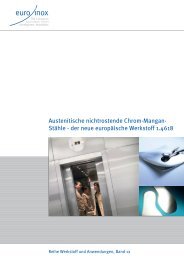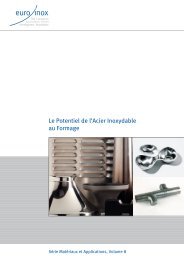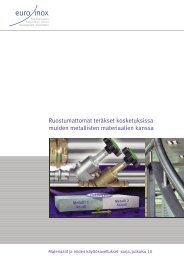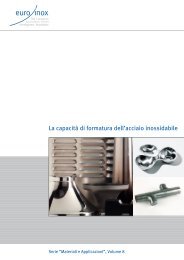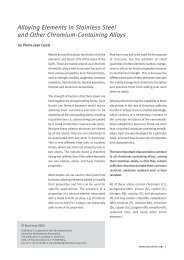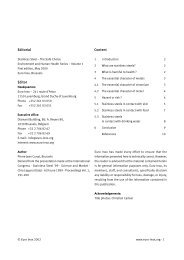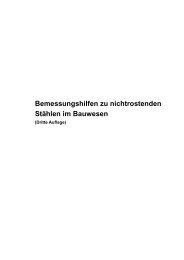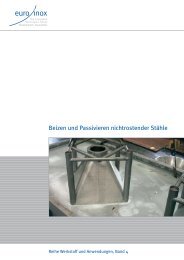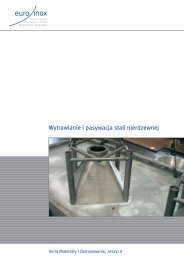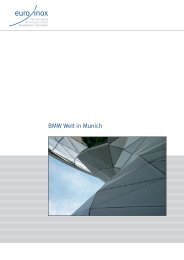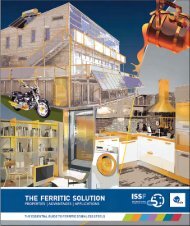Innovative Stainless Steel Applications in transport ... - Euro Inox
Innovative Stainless Steel Applications in transport ... - Euro Inox
Innovative Stainless Steel Applications in transport ... - Euro Inox
You also want an ePaper? Increase the reach of your titles
YUMPU automatically turns print PDFs into web optimized ePapers that Google loves.
4. Manufactur<strong>in</strong>g issues <strong>in</strong> lightweight structures<br />
The manufactur<strong>in</strong>g of any structure obviously requires several steps and techniques that<br />
are at least partially common eng<strong>in</strong>eer<strong>in</strong>g knowledge. However, there are certa<strong>in</strong><br />
methods worth a closer look, due to the different behaviour of, specifically, austeniticsta<strong>in</strong>less<br />
and mild or low-alloyed steels. Regard<strong>in</strong>g form<strong>in</strong>g, anisotropy <strong>in</strong> cold formed<br />
austenitic sta<strong>in</strong>less steel material requires particular attention, as expla<strong>in</strong>ed <strong>in</strong> Chapter<br />
2.3. Further <strong>in</strong>formation on the formability of sta<strong>in</strong>less steels is given by Van Hecke<br />
(2006).<br />
4.1 Bend<strong>in</strong>g of high strength sta<strong>in</strong>less steel sheets<br />
With conventional carbon steels, bend<strong>in</strong>g is usually carried out accord<strong>in</strong>g to the data <strong>in</strong><br />
DIN 6935 “Cold bend<strong>in</strong>g of flat rolled steels” (1975). This standard prescribes the<br />
m<strong>in</strong>imum bend<strong>in</strong>g radii for a wide variety of steels. Austenitic sta<strong>in</strong>less steels <strong>in</strong> general<br />
and especially the unstable grade 1.4318 exhibit higher strength than ferritic carbon<br />
steels and have different form<strong>in</strong>g behaviour.<br />
DIN 6935 ranks the available steel grades accord<strong>in</strong>g to ultimate tensile strength, <strong>in</strong> three<br />
categories: Rm < 390 N/mm 2 , 390 < Rm < 490 N/mm 2 and 490 < Rm < 640 N/mm 2 . A<br />
m<strong>in</strong>imum bend<strong>in</strong>g radius is given for each category. The ultimate tensile strengths, as<br />
measured by a quasi-static tensile test us<strong>in</strong>g a s<strong>in</strong>gle crosshead speed of 2.7 mm/m<strong>in</strong>,<br />
and the correspond<strong>in</strong>g m<strong>in</strong>imum bend<strong>in</strong>g radii of the project materials, are given (where<br />
possible) <strong>in</strong> Table 19.<br />
Table 19. Ultimate tensile strength and m<strong>in</strong>imum bend<strong>in</strong>g radius accord<strong>in</strong>g to DIN 6935 (1975).<br />
Material t<br />
(mm)<br />
Rm<br />
(N/mm 2 )<br />
90 °<br />
73<br />
Rm<br />
(N/mm 2 )<br />
90 °<br />
rm<strong>in</strong><br />
(mm)<br />
0 °<br />
rm<strong>in</strong><br />
(mm)<br />
90 °<br />
1.4318 2H/C1000 (301LN) 1.9 1119 1129 NA (4*) NA (4*)<br />
1.4318 2H/C850 (301LN) 1 961 947 NA (1.6*) NA (1.6*)<br />
1.4301SP 2B (304SP) 1 755 755 1.6 1.6<br />
1.4318 2H/C1000 (301LN) 1.2 1070 1073 NA (2.5*) NA (2.5*)<br />
1.4318 2H/C850 (301LN) 1.5 1055 1049 NA (2.5*) NA (2.5*)<br />
*values <strong>in</strong> brackets are those of the highest strength category of DIN 6935<br />
As can be seen from Table 19, the ultimate tensile strengths of most of the DOLTRAC<br />
materials are too high for the highest categories mentioned <strong>in</strong> DIN 6935. This standard<br />
is therefore not suitable for determ<strong>in</strong><strong>in</strong>g the m<strong>in</strong>imum bend<strong>in</strong>g radius of the ultra highstrength<br />
grades <strong>in</strong>vestigated <strong>in</strong> this project. Rules of thumb for m<strong>in</strong>imum bend<strong>in</strong>g radii<br />
of high-strength austenitic sta<strong>in</strong>less steels are however given by Ordenbach (1989). The



